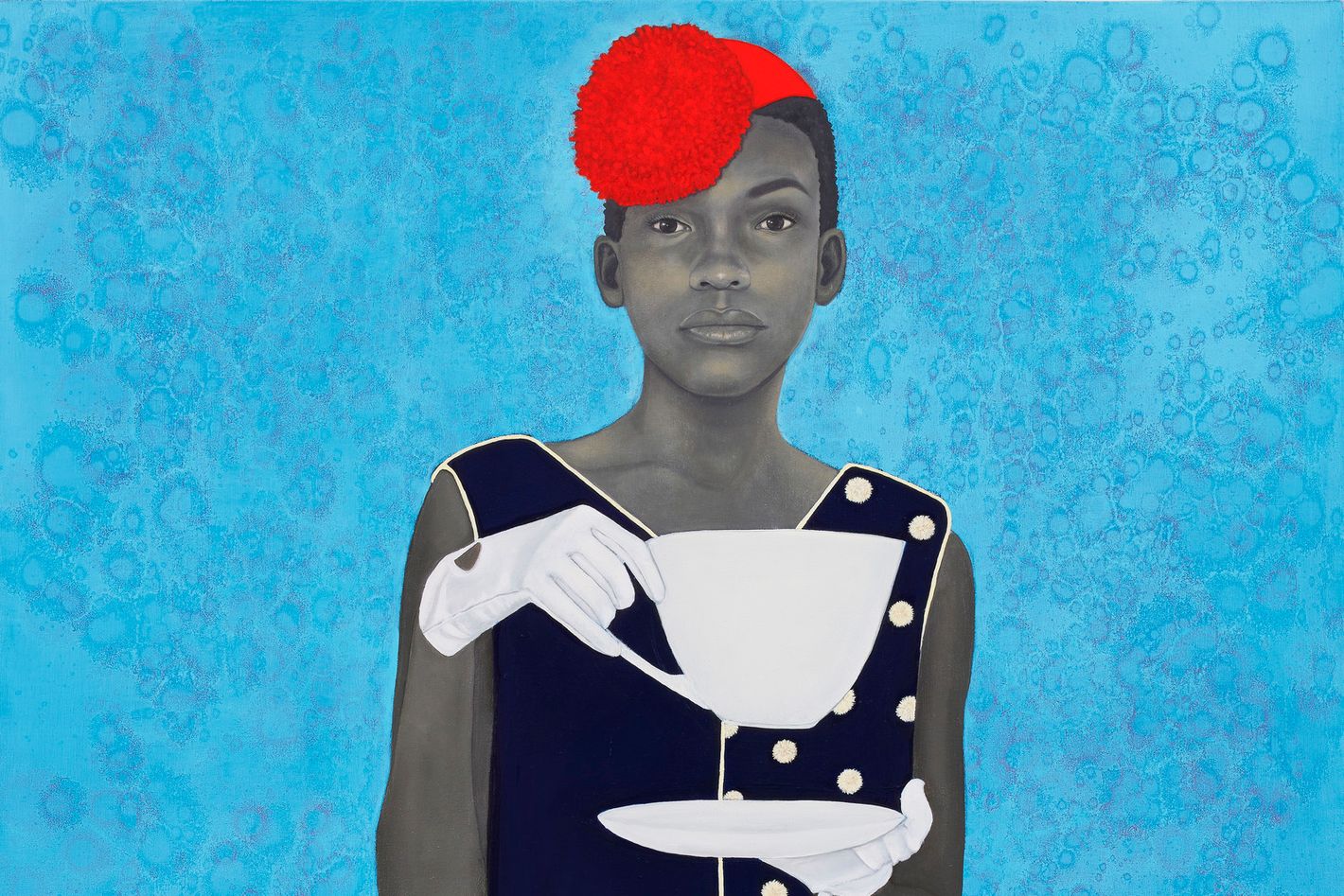

The artist Amy Sherald is best known for her magnificent 2018 portrait Michelle LaVaughn Robinson Obama, which has been looked at, studied, and written about as much as any portrait in the 21st century. It features Obama resting her chin on her right wrist, her gaze both self-aware and probing. She seems to be sizing us up as much as the other way around, forcing the viewer back on their own preconceptions about the first Black First Lady. Wearing a wonderful quiltlike sleeveless maxi dress by designer Michelle Smith, this woman radiates a casual gravitas. She is suspended in a field of turquoise paint, her skin tone a pewter-gray grisaille, which removes her from our realm and gives her an almost alien interiority and agency.
Most people only know Sherald through photographs of this one work. But as Sherald has said, “I had a career before Michelle Obama.” This is more than evident in her new mid-career survey at the Whitney, “American Sublime,” an experience in having your breath taken away. The first sight is a great curved wall with five portraits of Black subjects. They are like sentinels watching us, guardians of a majestic legacy, reminiscent of that army of terra-cotta warriors.
Sherald’s story is one of overnight skyrocketing success preceded by a lifetime of work. When she created the Obama portrait, she was 45 years old, living in Baltimore, having only left her waitressing job at 37. Six years before this, she had undergone a heart transplant. Sherald calls her career “plain old perseverance,” saying, “I painted up until the day I went into the hospital.” It now feels like this self-described late bloomer is in a race against time. Her art fetches astronomical auction prices of $3 million to $4 million. She laughs at the fact that she’s now “treated like a basketball player” with “sixth-graders squealing” at the sight of her.
I was on the 2016 jury that selected Sherald, then a relative unknown, as winner of the National Portrait Gallery’s Outwin Boochever Portrait Competition. I remember setting eyes on her submission resting against the wall of a long hallway: Miss Everything (Unsuppressed Deliverance), a medium-size portrait of a young Black girl with slate-gray skin and a no-nonsense gaze outfitted in a simple polka-dot dress. She wears white gloves, raising an oversize Alice in Wonderland teacup against a blue background that squishes the figure forward as if she were in bas-relief.
It was the very end of a second long day, and the lack of familiar Black narratives of pain, memory, and injustice gave me pause. I was also vexed by the lack of formal radicality. This picture looked like credible illustration. I was going to vote “No” but had to leave the jury early and arranged to call my vote in when I returned to New York. What a train ride home! Staring at a picture I had taken of the painting, I realized that Sherald was creating a stern, decorous way for us to rethink Black identity. This was a rigorous, formally flowing work about being young and alive and a little aloof from history. I voted for the painting, which marked a turning point in my taste. Seeing it again at the Whitney, it practically seethes with subtleties.
Straight-on portraiture may be the most challenging genre. Basically, a portrait is a figure and ground. Efforts to transform or romanticize portraits fall flat, and Sherald knows this. Sherald’s backgrounds are generally monochromatic, and her figures are rendered in what has become her signature gray tone. She has a very particular fashion sense that includes retro looks, Americana, patterned fabrics and uniforms. These figures — who often come from photographs Sherald has taken or appropriated — look back at us, claiming our attention and their own autonomy. Each is poised, self-possessed, but a little wary of our gaze.
I prefer the single portraits for their intense focus, the way a person isolated in a great field amplifies their presence. Or slaps us awake. If You Surrendered to the Air, You Could Ride It is a 2019 restaging of the famous 1932 photograph Lunch Atop a Skyscraper. Rather than white workers, Sherald pictures a dapper man wearing a red cap, a white turtleneck, an orange belt, and orange striped pants. His legs and feet disappear behind the green girder. A vast blue sky envelopes and vivifies this absolutely self-aware being who looks right at us. Less successful, but more ambitious, is Precious Jewels by the Sea, a rare four-person portrait of bathers at a beach that echoes Alex Katz.
In 2020, amid the mass protests following the murder of George Floyd, Sherald was commissioned by Vanity Fair to portray Breonna Taylor. Against a peacock-blue ground, we see a beautiful young woman in a blue dress, a cross around her neck and an engagement ring on her finger. We witness not a martyr or tragedy or the long America night, but something like an icon, a saint, a redemptive memorial.
Sherald’s show comes at what feels like an important art-historical moment. This spring, four major Manhattan museums are having one-person shows of African American artists. In addition to the Whitney’s Sherald show, MoMA is staging a grand survey of the late Jack Whitten; the Guggenheim has a retrospective of art star Rashid Johnson; and the Met opens a survey of Lorna Simpson in May. All four artists are represented by the same gallery, the prestigious Hauser & Wirth. In the past, this sort of one-sided favoritism would have made for scandal. But the art world has changed; the scandal, now, is how these artists were treated in the past.

Latest News
For Sale! 2016 Sea Ray 350 Sundancer – $180,000
Reel Deal Yacht is pleased to feature a meticulously maintained 2016 Sea...
Pharrell Williams’s Auction Platform Joopiter Collaborates with Martha Stewart for Inaugural Contemporary Art Sale
Joopiter’s Inaugural Contemporary Art Auction: A New Era in Collecting Joopiter, the...
About 3 in 10 US adults follow women’s sports, a new AP-NORC poll finds
When Meghan Sells heads to Providence Park to watch Oregon’s professional women’s...
Ancelotti focused on finishing ‘spectacular adventure’ with Madrid before taking over Brazil job
Carlo Ancelotti wants to finish his “spectacular adventure” with Real Madrid on...
Yankees 3B Oswaldo Cabrera leaves game vs. Mariners in ambulance following awkward home plate slide
Yankees third baseman Oswaldo Cabrera was taken off the field in an...













